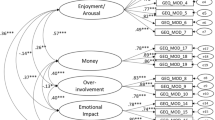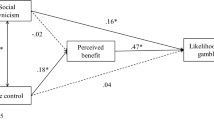Abstract
Compared to college females, college males are more likely to report frequent gambling. Research on gambling outcome expectancies has shown that expectations about gambling influence gambling behavior and that endorsement of particular expectancies differs by gender. Knowledge regarding the differential predictive utility of specific gambling expectancies based on gender would help to determine how beliefs about gambling may be fundamentally different for men and women. The present study explored whether gender moderates the relation between gambling expectancy and gambling frequency in a college sample. 421 college students completed an online survey that included questions about their demographics, gambling frequency, and gambling expectancies. Hierarchical regression analyses indicated that gender moderated the relations between the expectancies of social consequences, material gain, and gambling frequency. For females, greater endorsement of social consequences predicted less frequent gambling. For both males and females, greater endorsement of material gain predicted more frequent gambling. The current findings can help inform prevention and intervention efforts by identifying gambling expectations that are differentially related to college student gambling behavior choices.
Similar content being viewed by others
References
Aiken, L. S., & West, S. G. (1991). Multiple regression: Testing and interpreting interactions. Newbury Park: Sage.
Bandura, A. (1977). Social learning theory. Englewood Cliffs: Prentice Hall.
Barnes, G. M., Welte, J. W., Hoffman, J. H., & Tidwell, M. C. O. (2010). Comparisons of gambling and alcohol use among college students and noncollege young people in the United States. Journal of American College Health, 58(5), 443–452.
Blinn-Pike, L., Worthy, S. L., & Jonkman, J. N. (2007). Disordered gambling among college students: A meta-analytic synthesis. Journal of Gambling Studies, 23(2), 175–183.
Blom, G. (1958). Statistical estimates and transformed beta variables. New York: Wiley.
Botvin, G. J., Baker, E., Dusenbury, L., Tortu, S., & Botvin, E. M. (1990). Preventing adolescent drug abuse through a multimodal cognitive-behavioral approach: Results of a 3-year study. Journal of Consulting and Clinical Psychology, 58(4), 437–446.
Carlson, S. R., & Johnson, S. C. (2012). Impulsivity is not always associated with student drinking: A moderation study of impulsivity and drinking by positive alcohol expectancies. Addictive Behaviors, 37, 556–560.
Carlson, S. R., Johnson, S. C., & Jacobs, P. C. (2010). Disinhibited characteristics and binge drinking among university student drinkers. Addictive Behaviors, 35, 242–251.
Dager, A. D., Anderson, B. M., Stevens, M. C., Pulido, C., Rosen, R., Jiantonio‐Kelly, R. E., & Pearlson, G. D. (2012). Influence of alcohol use and family history of alcoholism on neural response to alcohol cues in college drinkers. Alcoholism: Clinical and Experimental Research. doi:10.1111/j.1530-0277.2012.01879.x.
Darkes, J., & Goldman, M. S. (1993). Expectancy challenge and drinking reduction: Experimental evidence for a mediational process. Journal of Consulting and Clinical Psychology, 61(2), 344–353.
Dunn, M. E., Lau, H., & Cruz, I. Y. (2000). Changes in activation of alcohol expectancies in memory in relation to changes in alcohol use after participation in an expectancy challenge program. Experimental and Clinical Psychopharmacology, 8(4), 566–575.
Engwall, D., Hunter, R., & Steinberg, M. (2004). Gambling and other risk behaviors on university campuses. Journal of American College Health, 53(6), 245–255.
Gillespie, M. A., Derevensky, J., & Gupta, R. (2007a). Adolescent problem gambling: Developing a gambling expectancy instrument. Journal of Gambling Issues, 19, 51–68.
Gillespie, M. A., Derevensky, J., & Gupta, R. (2007b). The utility of outcome expectancies in the prediction of adolescent gambling behavior. Journal of Gambling Issues, 19, 69–85.
Ginley, M.K., Whelan, J.P., Relyea, G.W., Simmons, J.L., Meyers, A.W., & Pearlson, G.D. (2013). College student beliefs about wagering: An evaluation of the adolescent gambling expectancies survey. Journal of Gambling Studies. Advance online publication. doi:10.1007/s10899-013-9403-8.
Gupta, R., & Derevensky, J. (1998). An empirical examination of jacobs’ theory of addictions: Do adolescent gamblers fit this theory? Journal of Gambling Studies, 14, 17–49.
Hodgins, D. C., & Mararchuk, K. (2003). Trusting problem gamblers: Reliability and validity of self-reported gambling behavior. Psychology of Addictive Behaviors, 17, 244–248.
Holmbeck, G. N. (2002). Post-hoc probing of significant moderational and mediational effects in studies of pediatric populations. Journal of Pediatric Psychology, 27, 87–96.
Jones, B. T., Corbin, W., & Fromme, K. (2001a). A review of expectancy theory and alcohol consumption. Addiction, 96(1), 57–72.
Jones, B. T., Corbin, W., & Fromme, K. (2001b). Half full or half empty, the glass still does not satisfactorily quench the thirst for knowledge on alcohol expectancies as a mechanism of change. Addiction, 96(11), 1672–1674.
LaBrie, R. A., Shaffer, H. J., LaPlante, D. A., & Wechsler, H. (2003). Correlates of college student gambling in the United States. Journal of American College Health, 52(2), 53–62.
LaPlante, D. A., Nelson, S. E., LaBrie, R. A., & Shaffer, H. J. (2006). Men & women playing games: Gender and the gambling preferences of Iowa gambling treatment program participants. Journal of Gambling Studies, 22(1), 65–80.
Larimer, M. E., & Neighbors, C. (2008). Normative misperception and the impact of descriptive and injunctive norms on college student gambling. Psychology of Addictive Behaviors, 17, 235–243.
Larimer, M. E., Neighbors, C., Lostutter, T. W., Whiteside, U., Cronce, J. M., Kaysen, D., et al. (2012). Brief motivational feedback and cognitive behavioral interventions for prevention of disordered gambling: A randomized clinical trial. Addiction, 107(6), 1148–1158.
Lesieur, H. R., & Blume, S. B. (1987). The south oaks gambling screen (SOGS): A new instrument for the identification of pathological gamblers. The American Journal of Psychiatry, 144(9), 1184–1188.
Neighbors, C., Lostutter, T. W., Whiteside, U., Fossos, N., Walker, D. D., & Larimer, M. E. (2007). Injunctive norms and problem gambling among college students. Journal of Gambling Studies, 23(3), 259–273.
Nowak, D. E., & Aloe, A. M. (2013). The Prevalence of pathological gambling among college students: A meta-analytic synthesis, 2005–2013. Journal of Gambling Studies, 1–25.
Petry, N. M., Weinstock, J., Morasco, B. J., & Ledgerwood, D. M. (2009). Brief motivational interventions for college student problem gamblers. Addiction, 104(9), 1569–1578.
Shaffer, H., & Hall, M. (2001). Updating and refining meta-analytic prevalence estimates of disordered gambling behavior in the United States and Canada. Canadian Journal of Public Health, 92(3), 168–172.
Sher, K. J., Wood, M. D., Wood, P. K., & Raskin, G. (1996). Alcohol outcome expectancies and alcohol use: A latent variable cross-lagged panel study. Journal of Abnormal Psychology, 105, 561–574.
Welte, J. W., Barnes, G. M., Wieczorek, W. F., Tidwell, M. C. O., & Parker, J. C. (2004). Risk factors for pathological gambling. Addictive Behaviors, 29(2), 323–335.
Whelan, J. P., Steenbergh, T. A., & Meyers, A. W. (2007). Problem and pathological gambling. Cambridge: Hogrefe and Huber.
Wickwire, E. M., Whelan, J. P., & Meyers, A. W. (2010). Outcome expectancies and gambling behavior among urban adolescents. Psychology of Addictive Behaviors, 24(1), 75–88. doi:10.1037/a0017505.
Author information
Authors and Affiliations
Corresponding author
Rights and permissions
About this article
Cite this article
Teeters, J.B., Ginley, M.K., Whelan, J.P. et al. The Moderating Effect of Gender on the Relation Between Expectancies and Gambling Frequency Among College Students. J Gambl Stud 31, 173–182 (2015). https://doi.org/10.1007/s10899-013-9409-2
Published:
Issue Date:
DOI: https://doi.org/10.1007/s10899-013-9409-2




